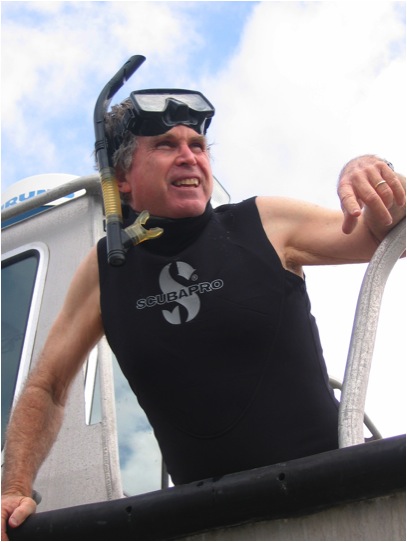
Obituary Notice: Renowned Research Physiologist Jeffrey B. Graham
Expert on fish respiration and locomotion
By:
- Robert Monroe
Published Date
By:
- Robert Monroe
Share This:
Article Content

Jeffrey Graham
Jeffrey B. Graham, a research physiologist at Scripps Institution of Oceanography, UC San Diego, died of cancer at his home in San Diego, Calif., on Dec. 8, 2011. He was 70 years old.
For nearly 50 years, Graham’s research focused on the evolution, comparative physiology and biology of fish, with special interests in fish respiration and locomotion. In addition, he specialized on species characterized as being “transitional” between the normal life history and physiology of the groups they represent. Examples include the sea snake Pelamis, which has “returned to the sea” and, unlike the majority of sea snake species never leaves the water. Another are tunas and lamnid sharks, considered “superfish” because of their many adaptations for elevated aerobic capacity and their extensive migrations that distinguish them from most other fishes. Graham also was a key researcher in air-breathing fishes, a diverse assemblage of species occurring among 50 families of osteichthyans (bony fish), some of which have partially emerged onto land.
Born on Nov. 26, 1941, in Portsmouth, VA, he received a B.A. degree in zoology in 1964, and an M.S. degree in biology in 1967, both from San Diego State University. He received a Ph.D. from Scripps Institution of Oceanography in 1970, under Richard Rosenblatt, renowned ichthyologist and curator emeritus of the Marine Vertebrate Collection. Graham served on the scientific staff of the Smithsonian Institution and was a professor of zoology at San Diego State University prior to joining Scripps.
Graham began his academic career as a zoology major at San Diego State University and upon graduation in 1964 planned to follow his mentor, Richard Etheridge, into a career in herpetology. Through that research he became interested in Pelamis, an extremely venomous sea snake, for its thermal biology, diving physiology and related processes such as buoyancy and the use of cutaneous respiration. He worked as an aquarium biologist at Scripps Aquarium, saw a general shift in his interest to fishes and began his Ph.D. studies at Scripps in 1967. During his graduate work he was awarded a pre-doctoral fellowship at the Smithsonian Tropical Research Institute in Panama to compare the temperature tolerances and thermal effects on metabolism in trans-isthmian congener fishes. He traveled to Panama to conduct his research, then returned to Scripps and finished his Ph.D. degree in 1970.
Subsequent work with Pelamis involved the first study of its swimming biomechanics both at the surface and at depth when the buoyant lung transforms the snake into a swimming “wing.” These studies of diving were the first to document that Pelamis breathed through its skin and that the lung had importance for subsurface buoyancy.
Again, Graham’s interest evolved and he began to study tuna physiology and was the first to discover a category of endothermic tunas, those having central heat exchangers positioned within greatly enlarged hemal arches (bony arches extending ventrally from the spinal column).
Graham was still conducting research at the time of his death.
At Scripps, Graham served as director of the Marine Biology Research Division and as associate director of the Center for Marine Biotechnology and Biomedicine. He also served as executive director of Birch Aquarium at Scripps from 2000 to 2002. During his tenure, the aquarium opened the Lynne and Howard Robbins Shark Reef, a 13,000-gallon live exhibit accompanied by interpretive panels on shark biology and conservation that displays shark species that inhabit tropical reefs. He also was responsible for introducing the current aquarium’s first seahorse exhibit, Secrets of the Seahorse, in 2002. The highly successful exhibit received the Munson Aquatic Conservation Exhibitry (M.A.C.E.) Award, which honors excellence in aquatic exhibits that incorporate conservation education.
In addition, Graham started the aquarium’s monthly public lecture series, which was renamed the Jeffrey B. Graham Perspectives on Ocean Science to honor him in 2002.

Jeffrey Graham with students
“Jeff’s efforts revitalized the aquarium during a very crucial time, and he was a tremendous colleague who I will miss greatly,” said Nigella Hillgarth, Ph.D., executive director of Birch Aquarium at Scripps.
Prof. Lawrence Frank in the Department of Radiology at the UC San Diego School of Medicine said that one of Graham’s greatest strengths was his ability to cross disciplines and bring people together to pursue innovative ideas. In 2001, Frank attended a shark dissection being performed by Graham as part of the first live webcast from the Birch Aquarium. The ensuing conversation led to a new collaborative research direction to use magnetic resonance imaging (MRI) for comparative anatomical studies in sharks, and subsequently to a project to digitize the specimens housed in the Marine Vertebrate Collection at Scripps using MRI. The National Science Foundation awarded Frank and collection curators a five-year, $2.5 million grant to launch the Digital Fish Library, a project that lets students and researchers around the world study fish anatomy via computer. Frank had been working with Graham on imaging projects until just weeks before Graham’s death.
“He was always about new ideas and was a really great facilitator,” said Frank. “He had a profound influence on me.”
Graham was awarded a John Simon Guggenheim Memorial Foundation Fellowship in 1987, and he received the Most Distinguished Alumni Award for 1975 from the College of Sciences and Alumni Association at San Diego State University (SDSU). He was elected to Phi Beta Kappa at SDSU in 2001.
Graham was a member of the American Association for the Advancement of Science, Sigma Xi, and the American Physiological Society, and has published more than 165 scientific papers and the book "Air-Breathing Fishes: Evolution, Diversity, and Adaptation," the authoritative reference on fish air breathing physiology published in 1997.
On Nov. 17 Graham was honored by nearly 200 colleagues, friends and family in a day-long event at Scripps Oceanography that celebrated his extraordinary scientific career, numerous achievements in research, teaching and mentoring, and his friendship.
In Graham’s own words, “My scholarly journey began on land, moved into the sea, and considered the suite of physiological adaptations acquired by groups moving between the two. Along the way I have enjoyed the generosity of mentors, the pleasures of discovery and the good camaraderie of like-minded friends and colleagues.”
In addition to Graham’s work as a scientist, he was also an accomplished artist. He had always been interested in painting and re-discovered this interest in the process of making scientific illustrations for his research. He worked exclusively with oils on canvas and board. His subjects were both land and seascapes, still life and portraits, which include portraits of all of his grandchildren and his good friend at Scripps Oceanography Richard Rosenblatt. The Rosenblatt portrait is on display at the Scripps Institution of Oceanography Marine Vertebrate Collection.
Graham is survived by his wife, Rosemarie; son Jeffrey, Jr. (Nancy); and daughters Wendy (Brian) and Erin; five grandchildren, Tate, Hailey, Nolan, Dylan and Melanie; brothers Doug and Barry; and sister Diana.
Memorial services are pending. The family asks that in lieu of flowers, donations be made to Birch Aquarium at Scripps in memory of Jeff Graham.
Share This:
You May Also Like
Stay in the Know
Keep up with all the latest from UC San Diego. Subscribe to the newsletter today.


